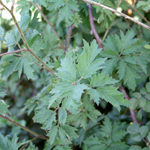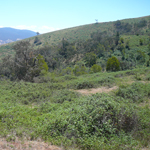Blackberry
Blackberry is an invasive shrub. It is a threat to agriculture in Victoria due to its rapid growth and spread.
Common name:
- Blackberry
Scientific name:
- Rubus fruticosus L. agg
Other scientific names:
- The aggregate contains at least 9 distinct species in Victoria, along with hybrids
Other common name:
- European blackberry
Plant status
Catchment management authority boundaries
Regionally controlled in the North Central, Corangamite, Port Phillip and Western Port, Goulburn Broken, North East, West Gippsland, East Gippsland, Wimmera and Glenelg Hopkins catchments.
Restricted in the Mallee catchments.
Plant biology
Appearance
Shrub (or bush)
Description
Blackberry is a perennial, semi-deciduous, prickly, scrambling invasive plant. It is a semi-prostrate to almost-erect shrub, with arching and entangling stems arising from a woody crown and forms thickets up to several metres high. The root and crown system is the only perennial part of the plant.
Stems
Blackberry stems are erect, or semi-erect, canes that arch or trail up to 7m long. They can be green, purplish or red, smooth or moderately hairy, round or angled, with numerous curved or straight prickles of different sizes and sometimes with small, stalked glands.
The canes are normally biennial, dying off after fruiting, but may occasionally live longer. Canes that have arisen from the crown in the current year (first-year canes, known as primocanes) usually do not produce flowers. Second-year canes (floricanes) grow as side shoots from the primocanes during the second year of growth and bear the flowers and fruit.

Leaves
The leaves of blackberry plants are alternate, compound, with three or five oval leaflets.
Leaves on primocanes have mostly 5 leaflets.
Those on floricanes mostly have 3 leaflets.
Simple leaves (not divided into leaflets) often occur near the flowers.
Leaflets are usually dark green on the top side and lighter green underneath, with small teeth around the edges. The underside is covered with whitish hairs in some species. There may be short prickles on the leaf stalks and the underside of veins. These are usually shed or partially shed in winter.

Flowers
Blackberry flowers are 2 to 3cm in diameter, growing in clusters on side branches of floricanes, with 5 sepals and 5 white or pink petals and numerous stamens.
Fruit
Blackberry fruit is in the form of a berry.
The berries are 1 to 3cm diameter, changing colour from green to red to black as it ripens — each berry an aggregate of many single-seeded juicy segments (drupelets). Fruit develops from late December until April.

Seeds
Blackberry seeds are deeply and irregularly pitted, light to dark brown, oval and 2 to 3mm long.
Roots
Blackberry plants have a main vertical root which grows to a maximum depth of 1.5m, depending on the soil type where it is growing. This root grows from a woody crown which is up to 20cm in diameter. Numerous secondary roots grow horizontally from the crown for 30 to 60cm and then vertically down. There are many thin roots in all directions from the secondary roots.
Growth and lifecycle
Method of reproduction and dispersal
Blackberry fruit are eaten by birds, foxes and other mammals which distribute seeds over wide areas.
Seeds are transported by water along creeks, drains and rivers.
Movement of contaminated soil and cultivation also spread blackberry.
Infestations increase in size by the formation of daughter plants at the end of canes, up to 6m from the crown.
Rate of growth and spread
Blackberry seedlings are not very vigorous in their fist year but after a woody crown is formed, they become firmly established. New canes are produced from the crown each spring and frequently project horizontally for over 3m from the crown after one growing season.
Canes in their first year of growth (primocanes) do not flower or fruit, but can produce daughter plants where they touch the ground in autumn. Daughter plants are usually produced close to the tip of the cane and the cane tip can continue to extend after the daughter plant is formed.
In their second year, the primocanes produce side shoots (floricanes) that bear flowers, and fruit from late December to April.
Canes that have borne fruit die back to the crown over autumn and winter. Leaves may be shed in winter, leaving a plant with living, year-old primocanes and daughter plants that are growing independently. Daughter plants produce first-year canes the following spring.
Seedbank propagule persistence
Blackberry seeds germinate mainly between September and November. Germination rates are low (around 30 per cent of seed), but are markedly higher for seed that has been eaten and voided by birds or mammals. Approximately 1 per cent of seed germinates in the first year, and 10 per cent within 3 years. The longevity of seed in the soil is currently unknown.
Similar species
Species in the aggregate
In Eurasia, there are over 2000 named entities in the Rubus fruticosus aggregate, arranged into 66 relatively distinct species. All have compound leaves and ripe fruit that are black and remain attached to the receptacle (the central and basal axis of the fruit). The species comprising the aggregate that are currently recognised as being present in Victoria are:
- R. anglocandicans (previously as R. procerus, R. discolor, R. chloocladus and R. ulmifolius hybrids)
- R. cissburiensis
- R. echinatus
- R. erythrops (previously R. rosaceus)
- R. laciniatus
- R. leucostachys (previously as R. chloocladus)
- R. polyanthermus
- R. ulmifolius
- R. vestitus
Identifying blackberry species can be difficult and it is important to correctly identify which species is present because they do not all respond similarly to control measures.
Similar native species
Care should be taken to distinguish the 3 native Rubus found in Victoria, all of which have red or orange fruit that fall away from the receptacle when ripe. Two are restricted to forests of eastern Gippsland, east from Maffra (Queensland bramble R. moluccanus and rose-leaf bramble R. rosifolius). The other is common through most of the southern half of the state and the north east (small-leaf bramble or native raspberry R. parvifolius). The latter species crosses with R. moluccanus to form the rare hybrid R. x novus, also known from Victoria.
Queensland bramble leaves are not divided into leaflets, but may be shallowly 3 to 5 lobed. Rose-leaf bramble has stems, leaf stalks and sepals densely covered with long, reddish, gland-tipped bristles, and a leaf with three leaflets. Small-leaf bramble has densely hairy young canes, leaves are almost hairless on the underside and are abundant small, strong, hooked stem prickles.
Other similar species
Other Rubus species that are not part of the R. fruticosus aggregate have been noted in small naturalised populations in Victoria or have occasionally been found as garden escapees. These include raspberry R. ideaus, wine raspberry R. phoenicolasius, keriberry R. rugosus and North American blackberry species that are commercially cultivated for their fruit. The North American species have non-paniculate flower heads, longer flower stalks, and glands on the primocanes.
So-called 'thornless' blackberries are part of a large complex of Rubus hybrids derived from several different species over a long period by commercial breeders. They have complicated pedigrees which include both European and American blackberry species. Possibly these varieties can cross with other species of European blackberry and create new hybrids. Thornless blackberries are not recorded as weeds in Australia.
European blackberry may also be confused with species of Rosa, including sweet briar, Rosa rubiginosa, a declared noxious weed, and the dog rose, Rosa canina. The fruit of these roses is an orange, red or almost black 'hip', not an aggregate of small fleshy segments as in Rubus, and they have prickles that become readily detachable with age.
Origin
All the species in the aggregate that are found in Australia are of European origin.
Preferred habitat
Blackberry grows throughout all the higher rainfall (over 760mm annual average) regions of Victoria, particularly in bushland, forest plantations, along streams and on grazing land. Seedlings do not survive in areas with moderate or heavy shade.
Distribution
Blackberry can be found in areas with greater than 760mm annual rainfall, mainly on fertile soils. The blackberry aggregate has arguably reached the climatic limits (rainfall and temperature) of its potential range in Victoria, however individual species have not. Some are widespread, whereas others are still very restricted in distribution.
Growth calendar
The icons on the following table represent the times of year for flowering, seeding, germination, the dormancy period of Blackberry and also the optimum time for treatment.
| Jan | Feb | Mar | Apr | May | Jun | Jul | Aug | Sep | Oct | Nov | Dec | |
|---|---|---|---|---|---|---|---|---|---|---|---|---|
| Flowering |  |  |  | |||||||||
| Seeding |  |  |  |  |  | |||||||
| Germination |  |  |  | |||||||||
| Dormancy |  |  | ||||||||||
| Treatment |  |  |  |  |  |  | ||||||
| New Growth |  |  |  |  |  |  |  |  |  |
Impact
Impact on ecosystems and waterways
Blackberry is considered a serious environmental threat and is highly invasive. It can provide harbour and a food source for pest species, as well as serve to outcompete and eliminate other vegetation by excluding light from the soil surface.
In its early stages of infestation, blackberry will grow over, or occupy gaps in, native vegetation and, in later stages, can severely restrict regeneration in native forests.
Agricultural and economic impacts
Blackberry is an extremely serious agricultural threat, owing to its rapid growth and ability to reproduce through various methods. It is a highly invasive species that will readily establish on disturbed sites and infest large areas. Once established it is expensive to manage and can even be a fire hazard due to large amounts of dead canes.
The plant's strong prickles make it hazardous and unpalatable to grazing animals (except browsing animals, such as goats and deer) and impenetrable thickets provide harbour and food for pest animals such as rabbits and foxes, starlings and blackbirds. It may also restrict access to watercourses in forestry operations and for grazing animals.
Blackberry may affect the establishment and growth of both softwood and hardwood seedlings in plantation forestry.
Social value and health impacts
Blackberry can restrict access to and along watercourses which may affect recreational activities. It also produces strong prickles which make it objectionable to humans and in large infestations, may be a fire hazard due to large amounts of dead canes.
Management
Prescribed measures for the control of noxious weeds:
- application of a registered herbicide
- physical removal
- mulching.
Read about prescribed measures for the control of noxious weeds.
Other management techniques
Spread prevention, biological control and changes in land use practices may also support blackberry management after implementing the prescribed measures.
